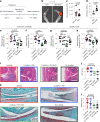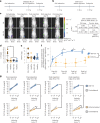Suppression of local inflammation via galectin-anchored indoleamine 2,3-dioxygenase
- PMID: 37127708
- PMCID: PMC10504068
- DOI: 10.1038/s41551-023-01025-1
Suppression of local inflammation via galectin-anchored indoleamine 2,3-dioxygenase
Abstract
The treatment of chronic inflammation with systemically administered anti-inflammatory treatments is associated with moderate-to-severe side effects, and the efficacy of locally administered drugs is short-lived. Here we show that inflammation can be locally suppressed by a fusion protein of the immunosuppressive enzyme indoleamine 2,3-dioxygenase 1 (IDO) and galectin-3 (Gal3). Gal3 anchors IDO to tissue, limiting the diffusion of IDO-Gal3 away from the injection site. In rodent models of endotoxin-induced inflammation, psoriasis, periodontal disease and osteoarthritis, the fusion protein remained in the inflamed tissues and joints for about 1 week after injection, and the amelioration of local inflammation, disease progression and inflammatory pain in the animals were concomitant with homoeostatic preservation of the tissues and with the absence of global immune suppression. IDO-Gal3 may serve as an immunomodulatory enzyme for the control of focal inflammation in other inflammatory conditions.
© 2023. The Author(s).
Conflict of interest statement
B.G.K. and G.A.H. are founders, hold stock and serve on the scientific advisory board of Anchor Biologics, Inc. The University of Florida related to molecules and their uses reported in this paper. The other authors declare no competing interests.
Figures




Comment in
-
Anchoring immunosuppression to inflamed tissue.Nat Biomed Eng. 2023 Sep;7(9):1060-1062. doi: 10.1038/s41551-023-01055-9. Nat Biomed Eng. 2023. PMID: 37353678 No abstract available.
References
Publication types
MeSH terms
Substances
Grants and funding
- R03 EB019684/EB/NIBIB NIH HHS/United States
- R01 DK098589/DK/NIDDK NIH HHS/United States
- R01 AI171045/AI/NIAID NIH HHS/United States
- R01 DE027301/DE/NIDCR NIH HHS/United States
- R01 AR079874/AR/NIAMS NIH HHS/United States
- UL1 TR001427/TR/NCATS NIH HHS/United States
- R01 DK091658/DK/NIDDK NIH HHS/United States
- R01 AR068424/AR/NIAMS NIH HHS/United States
- R01 AI133623/AI/NIAID NIH HHS/United States
- R01 AR071431/AR/NIAMS NIH HHS/United States
- T32 DK108736/DK/NIDDK NIH HHS/United States
- TL1 TR001428/TR/NCATS NIH HHS/United States
- R35 GM133697/GM/NIGMS NIH HHS/United States
LinkOut - more resources
Full Text Sources
Research Materials

